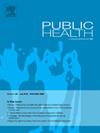Effectiveness of health literacy education on health literacy in early adolescence: A randomized controlled trial
IF 3.9
3区 医学
Q1 PUBLIC, ENVIRONMENTAL & OCCUPATIONAL HEALTH
引用次数: 0
Abstract
Objectives
The present study was conducted to measure the effectiveness of health literacy education on the health literacy level of children in early adolescence.
Study design
A parallel group randomized controlled trial was conducted.
Methods
The study group consisted of sixth and seventh-grade students (aged 12–13 years) studying in a secondary school in Ankara. The study was completed by 80 students, 40 in the intervention group and 40 in the control group. The Health Literacy Education program, consisting of four sessions, was presented to the intervention group. The instruments were administered to both groups before the intervention (pre-test), one month (post-test), and three months after the intervention (follow-up test). The data was analyzed using the chi-square test, and the two-way mixed-design variance analysis with Bonferroni Multiple Comparison Test.
Results
Before the study, the adolescents in the intervention and control groups were similar regarding descriptive characteristics (p > 0.05). There was no statistically significant difference between the pre-test health literacy mean scores of the intervention and control groups (p > 0.05). After the health literacy education, health literacy post-test scores and follow-up test mean scores of the intervention group increased significantly compared to the control group (p < 0.05). The intervention had a large effect size (F = 414.683; η2 = 0.91) at the 95 % confidence interval.
Conclusions
The study revealed that health literacy education was effective in increasing the level of health literacy in early adolescence. It is recommended that health literacy education be added to the school education curriculum of adolescents.
健康素养教育对青少年健康素养的影响:随机对照试验
研究目的本研究旨在衡量健康素养教育对青春期早期儿童健康素养水平的影响:研究设计:平行分组随机对照试验:研究小组由安卡拉一所中学的六年级和七年级学生(12-13 岁)组成。80名学生完成了研究,其中干预组40人,对照组40人。干预组的学生接受了由四节课组成的健康素养教育课程。两组学生分别在干预前(前测)、干预后一个月(后测)和干预后三个月(跟踪测试)进行了测试。数据分析采用了卡方检验和双向混合设计方差分析,并进行了 Bonferroni 多重比较检验:研究前,干预组和对照组青少年的描述性特征相似(P>0.05)。干预组和对照组在测试前的健康素养平均分差异无统计学意义(P>0.05)。研究表明,健康素养教育能有效提高青少年的健康素养水平。建议在青少年的学校教育课程中增加健康素养教育。
本文章由计算机程序翻译,如有差异,请以英文原文为准。
求助全文
约1分钟内获得全文
求助全文
来源期刊

Public Health
医学-公共卫生、环境卫生与职业卫生
CiteScore
7.60
自引率
0.00%
发文量
280
审稿时长
37 days
期刊介绍:
Public Health is an international, multidisciplinary peer-reviewed journal. It publishes original papers, reviews and short reports on all aspects of the science, philosophy, and practice of public health.
 求助内容:
求助内容: 应助结果提醒方式:
应助结果提醒方式:


